Griping
Monday, July 30th, 2007Please allow me a moment to indulge in negativity. I shan’t be long.
Top 10 Most Hated Kitchen Tasks
10. spraying oil
I detest this task on several levels. First of all, I hate using this stuff because it comes in a pressurized can which one cannot recycle. In fact, I’m not even sure how one is supposed to conscientiously dispose of such a thing- does it get tossed in the pile of noxious substances that go to the fire department for disposal? or le landfill? At any rate, it’s not the recycle bin. Secondly, it sprays evenly only when it is held upright which goes against its purpose entirely. Thirdly, using it creates a circumference of oil slicked surfaces that always goes beyond the intended coverage. Example: spray a muffin tin while it sits on the counter; the result is an oil slicked tin plus counter top plus backsplash plus, as a bonus, any tools sitting in the near vicinity. So maybe you pick up the tin and hold it perpendicular to the floor, thereby trying to outsmart the can and reduce the spray radius but the result is a slick tin and, worse, a slick floor in the area of the spraying. I imagine that in commercial kitchens, where people where shoes and it is someone else’s job to swab the floor each night, the oil slick thing is not a nuisance but for those of us who wear socks on linoleum and who clean slightly less frequently, the oil slick area is a slippery, slippery hazard for days.
9. thinly slicing cheese without a cheese slicer
In truth, this task could be called “doing anything without the appropriate tool for the job”. Never, never will I ever be able to slice perfect, thin, even slices of cheese with just a knife. It is mathematically impossible.
8. toasting nuts
It’s not so much the toasting of the nuts that I hate but rather, the inexplicable forgetfullness that accompanies this task and which results in burned nuts every time. Manually toasting while cooking is a perfect example of multi-tasking at its worst. This delicate technique of gently coaxing the oil and flavour from the nuts requires both eyes and undivided attention, at least in my case. If there is any deviation from this formula, and there always is, the nuts will burn.
7. desparately dealing with frozen phyllo that hasn’t yet thawed completely
There are several layers to this mistake, the first of which must be obvious. The second layer of stupidity follows, in which I try to speed up the thawing process with a microwave/low oven/sunbeam, etc. This practice only produces mush, still frozen in the middle. If I am still desparate enough to try to use the phyllo at this point, there is only descent into frustration, vexation and surrender.
6. grating ginger
Loathsome chore, this takes forever, scrapes fingers and knuckles and leaves more ginger on the grater than in the bowl at the end. This fibrous root is barely tolerable when chopping, let alone trying to shave it into pulp.
5. separating paste from tamarind
This was a mistake I will only make once. The vile task of pulling the flesh off the tamarind root (it is a root, isn’t it?) requires more patience than I have to give. I bought tamarind in non-paste form because I couldn’t find it in paste form figuring that it couldn’t be that hard to extract the good part from the bad but I was most seriously wrong. Nobody has any business using whole tamarind so why is it even packaged and sold?
4. slicing soft bread
At first glance, this might seem as though it should belong to Number 9, “doing anything without the appropriate tool for the job”. However, I would argue that even with a long, sharp, serrated knife, soft, warm bread will effortlessly resist every effort to be sliced. It wobbles back and forth with every draw across its back, slowly shrinking under the pressure of the knife and smashing back into the dough from whence it came. Best to tear.
3. peeling fava beans
Who invented fava beans! The ratio of work to flavour is, like, 12:1. Open the pods to fish out the beans, boil the beans only to peel the skin each nugget for the meat. The bean provokes me, actually, because the skin has a seam that looks as though it should easily peel back along that line but it is a bitter, bitter deception. After enough of this torture, my fingernails feel as though they have been peeled back.
2. thyme
Wretched herb! Such delicate little leaves persistantly attached to such a woody stem. If only the leaves were less clingy or the stem more pliable, I wouldn’t bother with the de-stemming production but it cannot be. I must painstakingly peel the leaves off, very nearly one by one, in order to take advantage of them. If only they could be more like their easy cousin rosemary- so simple to fold the “leaves” backwards and pull them all off the stem in one broad stroke!
1. washing lettuce
This is, and has always been, the task I hate the very most in the kitchen. Boring beyond measure, finicky, dull, and time-consuming: washing any kind of leaves for consumption is to be reviled. We used to buy pre-washed stuff all the time but now, here in California, organic fare is never washed and we do not have a salad spinner. Leaves cannot be left wet after washing – it would so ruin a salad as to not bother having salad at all – and air-drying or towel-drying are wiltifying and ineffective, respectively. Without a spinner, I almost don’t want to have salad at all; it is simply not worth enduring my most hated kitchen task of all time.
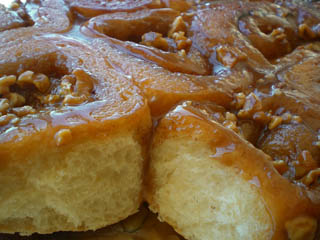 I was eyeing a bread baking book at Chapters before leaving on our around the world trip. Now that we’ve returned and I’ve been making bread again, I picked up
I was eyeing a bread baking book at Chapters before leaving on our around the world trip. Now that we’ve returned and I’ve been making bread again, I picked up 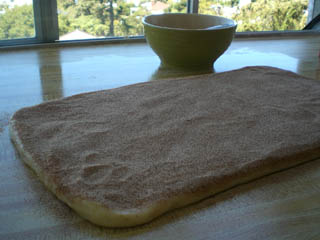 gave Janet a heart attack and that was in addition to the 1/2 cup of sugar that was rolled into the buns. Baking the buns was a bit of a challenge because the dough need to cook through to the bottom and the glaze needs to carmelize without turning into rock candy. In the end, most of the glaze was a little too stiff, but still tasty. If I had rotated the pan half way through and took them out five minutes earlier, they would have been perfect bakery-quality buns. Surprisingly, the glaze softened over the next 48 hours.
gave Janet a heart attack and that was in addition to the 1/2 cup of sugar that was rolled into the buns. Baking the buns was a bit of a challenge because the dough need to cook through to the bottom and the glaze needs to carmelize without turning into rock candy. In the end, most of the glaze was a little too stiff, but still tasty. If I had rotated the pan half way through and took them out five minutes earlier, they would have been perfect bakery-quality buns. Surprisingly, the glaze softened over the next 48 hours.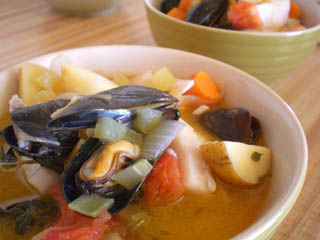 Janet’s first experiments in filleting a fish left us with excellent ingredients for fish stock, so we threw the cap and rake (read head and spine) into some water with a bay leaf and leek greens for about an hour. I’m told fish stock only needs a half hour, but I prefer to really work the fish smell into the house. When I’ve gone to all that trouble, I want people to walk into the house three days later and say, “Were you cooking fish?”
Janet’s first experiments in filleting a fish left us with excellent ingredients for fish stock, so we threw the cap and rake (read head and spine) into some water with a bay leaf and leek greens for about an hour. I’m told fish stock only needs a half hour, but I prefer to really work the fish smell into the house. When I’ve gone to all that trouble, I want people to walk into the house three days later and say, “Were you cooking fish?”
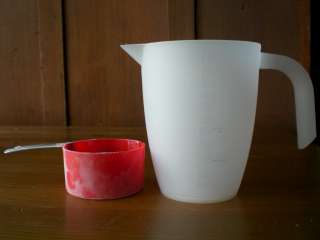 One disagreement that will forever be simmering under the surface of our kitchen dynamic is the difference between dry-measure and liquid-measure. Marc insists that one cup of dry equals one cup of liquid and I insist otherwise; surely there is a reason why they make nested measuring cups and separate ones with spouts. There have been experiments conducted in the kitchen to prove and disprove our opposing views and the result usually ends with a discussion of molecular make-up of liquids and solids and then with an agreement to disagree.
One disagreement that will forever be simmering under the surface of our kitchen dynamic is the difference between dry-measure and liquid-measure. Marc insists that one cup of dry equals one cup of liquid and I insist otherwise; surely there is a reason why they make nested measuring cups and separate ones with spouts. There have been experiments conducted in the kitchen to prove and disprove our opposing views and the result usually ends with a discussion of molecular make-up of liquids and solids and then with an agreement to disagree.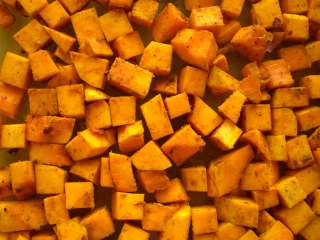 Living in Calgary at a high altitude for so long, I’m well in the habit of adjusting baking recipes to compensate for the pressure and that habit has further manifested itself in my cooking. If it seems silly to add three tablespoons of butter where two would do, then I’ll go with the two; if a recipe calls for fresh tarragon, I’ll double the amount because I love that herb. Marc, on the other hand, is much more scientifc about things. If the interweb says that scallops must be cooked at a temperature of 360°F for a period of time no greater than 2.6 minutes, then we’ll have to go out and buy a thermometer and a timer. His method yields perfectly cooked scallops every timewhile my method may yield perfectly cooked scallops some of the time, with lots of tarragon. Our focus is different, my results vary.
Living in Calgary at a high altitude for so long, I’m well in the habit of adjusting baking recipes to compensate for the pressure and that habit has further manifested itself in my cooking. If it seems silly to add three tablespoons of butter where two would do, then I’ll go with the two; if a recipe calls for fresh tarragon, I’ll double the amount because I love that herb. Marc, on the other hand, is much more scientifc about things. If the interweb says that scallops must be cooked at a temperature of 360°F for a period of time no greater than 2.6 minutes, then we’ll have to go out and buy a thermometer and a timer. His method yields perfectly cooked scallops every timewhile my method may yield perfectly cooked scallops some of the time, with lots of tarragon. Our focus is different, my results vary. Like a fool, I just grabbed a bag from the bin at the Berkeley Bowl that read “$3.69/lb” assuming – and this is where I went wrong – that they were one-pound bags. I mean, I don’t know how much a pound is, it just seemed logical. Marc wanted a second bag for eating and so we came home with an unexpected cherry expense of $15.99. Which seems outrageous at first but we would’ve spent that on a bottle of wine, so relatively speaking, I guess it is reasonable.
Like a fool, I just grabbed a bag from the bin at the Berkeley Bowl that read “$3.69/lb” assuming – and this is where I went wrong – that they were one-pound bags. I mean, I don’t know how much a pound is, it just seemed logical. Marc wanted a second bag for eating and so we came home with an unexpected cherry expense of $15.99. Which seems outrageous at first but we would’ve spent that on a bottle of wine, so relatively speaking, I guess it is reasonable.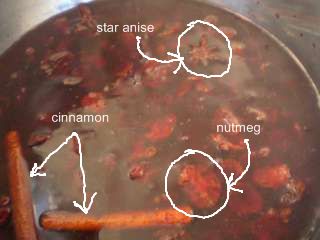 The remainder of the dried ones are going to be great in scones or muffins and the remainder of the bings are quickly disappearing as breakfast food. Notice the aromatics; I wouldn’t have thought to add these on my own.
The remainder of the dried ones are going to be great in scones or muffins and the remainder of the bings are quickly disappearing as breakfast food. Notice the aromatics; I wouldn’t have thought to add these on my own. Pictured at left is the cooked filling, which took about 40 minutes to make and over an hour to cool. Meanwhile, I made the
Pictured at left is the cooked filling, which took about 40 minutes to make and over an hour to cool. Meanwhile, I made the 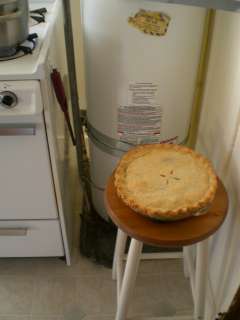

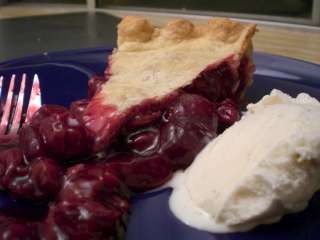
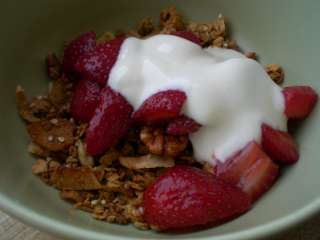
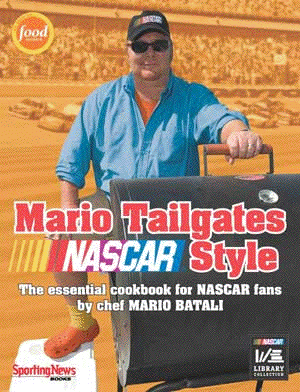

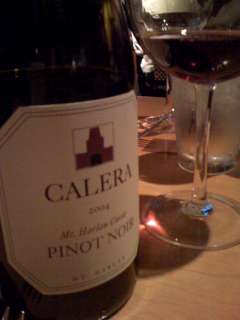
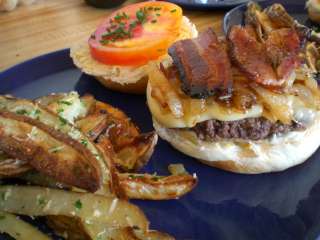 Any burger can be good, but one topped with melty perrano cheese, heirloom tomato, caramelized onions and applewood smoked bacon is breathtaking. That’s right, breathtaking. This drippy, juicy, sloppy, melty, gorgeous burger will remain at the top of the chart until challenged by a worthy opponent. I don’t see one on the horizon.
Any burger can be good, but one topped with melty perrano cheese, heirloom tomato, caramelized onions and applewood smoked bacon is breathtaking. That’s right, breathtaking. This drippy, juicy, sloppy, melty, gorgeous burger will remain at the top of the chart until challenged by a worthy opponent. I don’t see one on the horizon.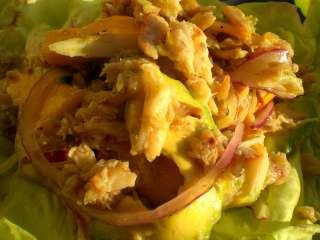 Because we can’t afford to pay $35/lb for fresh lumps of crab meat, we bought some canned stuff from India. The mango came from Mexico. The honey came from Austria and the olive oil is strangely somehow a “product of California and Tunisia”. (what?) Everything else – which is just the veg – was locally grown. Incidentally, though this sounds like it would be nothing but delicious, it was kind of bland.
Because we can’t afford to pay $35/lb for fresh lumps of crab meat, we bought some canned stuff from India. The mango came from Mexico. The honey came from Austria and the olive oil is strangely somehow a “product of California and Tunisia”. (what?) Everything else – which is just the veg – was locally grown. Incidentally, though this sounds like it would be nothing but delicious, it was kind of bland.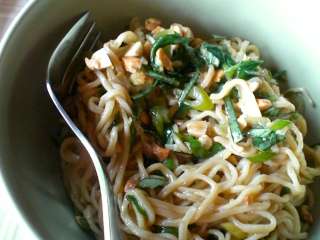 Sesame oil from Taiwan, soy sauce brewed in Wisconsin, kosher salt from Minneapolis, balsamic from Italy, and vegetable oil from Nebraska. I can’t figure out where the sugar came from and the Chinese noodles were actually made fresh by the Berkeley Bowl. Had I not made a point of looking for this information, I wouldn’t have given it a second thought. And yet, look how far all this stuff came just for me to make a salad! It’s actually pretty impressive. The salad itself made a great lunch but next time we’ll make it spicier.
Sesame oil from Taiwan, soy sauce brewed in Wisconsin, kosher salt from Minneapolis, balsamic from Italy, and vegetable oil from Nebraska. I can’t figure out where the sugar came from and the Chinese noodles were actually made fresh by the Berkeley Bowl. Had I not made a point of looking for this information, I wouldn’t have given it a second thought. And yet, look how far all this stuff came just for me to make a salad! It’s actually pretty impressive. The salad itself made a great lunch but next time we’ll make it spicier.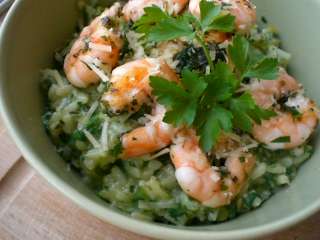 Except for the organic, free-range chicken broth (Oregon), the rice (Argentina) and the olive oil (California and Tunisia), it was made with local ingredients. Lucky for us, our kitchen is practically in the ocean and is next door to Napa valley; this meal would have been far more foreign had we made it in Calgary. The improvised shrimp was the best part.
Except for the organic, free-range chicken broth (Oregon), the rice (Argentina) and the olive oil (California and Tunisia), it was made with local ingredients. Lucky for us, our kitchen is practically in the ocean and is next door to Napa valley; this meal would have been far more foreign had we made it in Calgary. The improvised shrimp was the best part.